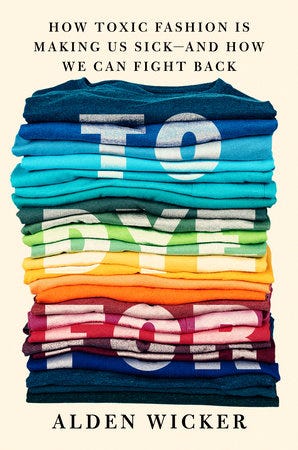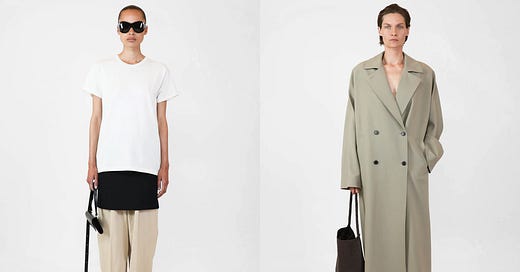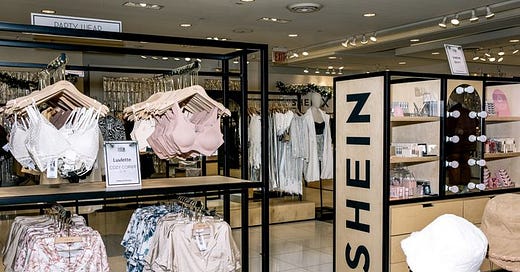

Discover more from Back Row
The Toxic Chemicals Sneaking Into Our Clothes
A new book explores how unregulated, invisible chemicals in apparel could be causing harm.
Around late 2010, Alaska Airlines started rolling out new uniforms for flight attendants. However, some started developing hives, migraines, scaly patches on skin, and rashes that were so bad they bled. The culprit seemed to be the uniforms, which were recalled in 2014. Similar episodes also occurred at Delta Airlines, American Airlines, and Southwest.
After fashion materials and sustainability expert Alden Wicker was asked to comment for a radio show about the airline uniforms, she decided to look into it more deeply and ultimately write a book about it, To Dye For: How Toxic Fashion Is Making Us Sick — and How We Can Fight Back, which is out today. The book explores through meticulous research and chilling examples how invisible chemicals in our clothes could be negatively impacting both the people who make these items and those who wear them.
As Wicker explains, research into chemicals in textiles and how they affect us is extremely limited, and it’s difficult in most cases to draw definitive conclusions. I also come back to
’s writing about how much we should worry about chemicals, such as phthlalates, in everyday items. They are certainly concerning and should be eliminated from things like food, but they are also everywhere, out of our control, and likely, she notes, exposed to most of us in very small quantities. Basically: individual action can only go so far in a deeply broken system.Wicker’s book makes a compelling case for the passage of bills like the Fashion Act, which would require brands of a certain size to understand exactly how their clothes are made and make disclosures to consumers (the fashion supply chain is opaque by design). It also makes a strong argument for the government to regulate chemicals that we are all exposed to, on apparel and elsewhere, and for funding better research into those applied to clothing.
Ahead, my conversation with Wicker about her book, which has been edited and condensed for clarity.
We are so used to hearing about “clean beauty” and “clean cleaning products” but we don’t really hear about clean clothing, which is really what your book is about.
Unlike those things, clothing doesn't have an ingredient list. I think that that has led to this false sense of security, where if it's 100 percent cotton, it has dye on it and that must be it. But there could be dozens of chemicals on one piece of fashion. In a test of an airline attendant uniform, one piece of fabric had 42 different chemicals. And those labs don't even test for every single chemical of 40,000 different chemicals that are in existence for commercial use because it's really expensive. And that test came up with arsenic and lead. It's been really well-hidden from consumers, just how many different chemicals are on a piece of clothing.
And just what are these chemicals?
There are all sorts of chemicals. Some of them are heavy metals, which have been a problem in fashion since forever — things like lead and arsenic. They could be added to make dye brighter, or they could be contaminants. A lot of them are essentially fossil fuels, so petrochemicals.
Some are applied and then stripped off by other chemicals with the factory dyes. Of course, anti-wrinkle finishes, performance finishes. Things that just make the clothing feel soft that'll get washed off by the consumer, just so when you're touching it in the store, you go, Oh, that's so nice, and then you buy it. Most of them, except for the dye, are completely invisible. Some of them have an odor, some of them don't.
You talk throughout the book about flight attendants getting sick from their uniforms. Why airline uniforms? I was shocked by how sick some of them got.
They have a ton of different performance chemicals — anti-wrinkle, flame retardants, ant-mold. A lot of the companies have switched from wool, which is naturally flame retardant, to polyester blends. One airline attendant told me that she could drop ketchup on her skirt and just sort of wipe it off. The only reason the airline attendants figured out what was happening was because they all got their uniforms at once, and a bunch of them started getting sick at the same time, and then they started talking to each other.
What kinds of symptoms did they experience?
Some of the health effects that they were having were horrendous. Some had their hair fall out completely. Some were just disabled by extreme fatigue. Rashes that were so bad that they would bleed. Breathing problems. It was partly because they wear these uniforms all the time for up to 12 hours a day. They have all of these different performance qualities that you would want from something that you're wearing all the time for work. I started looking into, well if this is happening to the airline attendants, is something like this happening to the rest of us? That's how I got into researching this book.
How many flight attendants have been affected?
There's only been one scientific survey conducted by Harvard that looked at symptoms before and after the uniform rollout that showed that it was indeed attributable to the uniforms. But all the other ones are self-reported. And it's coming from airline attendants who are so sick that they decide to report. They might fear being retaliated against by the airline, especially if they're not part of a union. So it's hard to say, but definitely thousands.
What has the airlines’ response been to all this?
The airlines and the uniform makers employed a few different strategies. One of them was hiring labs and consultants to have things tested, and then to give them a clean bill of health. They would say there is no substance that was found to be over the limits that could cause all of your symptoms. Some of them eventually did switch out their uniforms, because it was becoming a distraction, without ever acknowledging that it was the uniforms that caused the problem, because that would open them up to being sued by all of these attendants who've had their lives ruined.
They would say, “Point to the one chemical that's causing all of your symptoms.” But it's probably a bunch of different chemicals causing a bunch of different symptoms. So all of them could be under the limit, but you put them together and they have these synergistic effects where they help each other become more damaging. So they just sort of use the confusion and the lack of research to gaslight these attendants and tell them, “It's not the uniforms causing your disability, so it's not our fault. And if you don't work, eventually we're going to let you go.” A lot of attendants are really suffering and they've never gotten justice.
Why has there been so little scientific research about chemicals in clothing? Everybody wears clothes.
One reason is sexism, right? Is the fashion industry worthy of study? Does it help you get grants? When I first started looking into this, I reached out to a lot of researchers and most were like, I don't know anything about fashion. I study couches.
Why couches? Furniture, couches, and cushions seem to be commonly cited in stories about chemicals in everyday items in our homes or personal care products.
There's been this huge push to take away flame retardancy through legislation around couches and other things. For a long time when people smoked a lot, there was a real danger of falling asleep with a cigarette and setting your house on fire.
But we need more research on beauty products, we need more research on cleaning products. Again, these products come with ingredient lists. We have no idea what's in fashion. You could test for a lot of stuff, but it costs tens of thousands of dollars.
You traveled overseas to garment factories to see what was going on there. Can you talk abut what you saw?
I linked up with an amazing local journalist, Sujata Sivagnanam. She took me to Tirupur in India, which is where most of our T-shirts come from. This town is incredibly polluted, but it’s actually a little bit of a success story because legislation passed that ended up cleaning up the effluent that's coming out of these dye houses, so they're not allowed to discharge liquid into the rivers. I met a garment worker who pulled up her sari and she had these cauliflower[-like rashes] all over her legs, a reaction to the clothing. And she was lucky because her doctors believed her. Her doctor was like, “Oh, it's your job. You need to quit.” She was sewing in a factory that made polyester products for the domestic market. She ended up quitting her job, and her arms healed but her legs did not. And I suspect that's because she continues to wear polyester saris every day.
Do you feel like more chemicals may be getting into our clothing these days because so many people just wear performance fabrics (athleisure) all day every day?
It's really hard to make a profit on natural fibers without finishes. If you put a fancy performance finish on something, especially if you can give it a name and call it a trade secret, you can charge more for it. And you can make sure that nobody copies you and undercuts you. So that's actually driving a lot of this. Also, fashion brands are always trying to push down prices they're paying to manufacturers. And one way to save money is by buying cheaper chemicals from the guy down the street rather than verified chemical companies.
When I read your book I felt helpless to do much of anything, but also particularly concerned for my kids. What can we do?
I don't want to heap more stress on moms like yourself. You already have so much going on. I would just say that if your kids have health issues or sensitive skin and you're the kind of person who finds it worthwhile to buy non-toxic cleaning products and non-toxic personal care products, don't rule out fashion as another way that chemicals can get into your home and into your bodies.
A movement is gathering steam in this country to overhaul the way we regulate chemicals. The European Union is way, way ahead of us. But in the United States, only a handful of chemicals are regulated in children's products specifically. But in adult products, you could put something that's technically illegal to use or buy in the United States on an adult T-shirt, ship it over here, and you'd be doing nothing illegal.
There's a bright spot, which is California's Prop 65. That's why you see labels saying this product is known to the state of California to have toxic substances. But that's actually moved a lot of brands to get chemicals out of their products. And it's the reason why we know these chemicals are in their products, because it's opened the door for testing and suing brands that are not labeling their things as toxic when they have toxic chemicals in them.
You have a section in the book abut what consumers can do. Can you give us the highlights?
I would never recommend somebody buy something that's ultra-fast fashion or ultra-cheap. There was a big scandal a few years back when they tested some Shein children's products in Canada and found lead and phthalates. I'm also talking about the gibberish “brands” that you see on Instagram or Amazon. It does take money to do these tests, to have a long-term, strong relationships with manufacturers and get them to put in place processes or work with certifications.
Shop with brands who have a reputation for caring about chemical management. Some fast fashion brands have been working on this for a really long time — H&M and Levi's are two of them. Also, go for natural fibers when you can. That’s not a hard and fast rule, but for people who have chemical sensitivities or eczema, the dyes used on polyester are known sensitizers. You can also look for labels such as Blue Sign, Oeko-Tex, and GOTS Organic.
Will spending more on designer items save you from chemical exposure?
They don’t necessarily have a chemical management policy. There are plenty of high-end brands, mid-market brands that do not care. If they do not care, things are probably slipping through.
Follow Alden on Instagram at @EcoCultCom and get her book here.


















Also if you have sensitive skin wash your clothing before you wear it!! I have gotten terrible rashes/hives from the 'finishing' chemicals and had to return my brooks brothers 'no iron' shirts as they irritated my eczema. The salesperson said 'oh yea, that happens to some people' like...WHAT???
Thanks Amy, incredibly insightful…and terrifying!